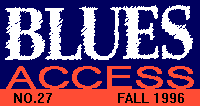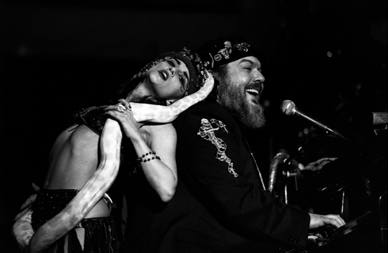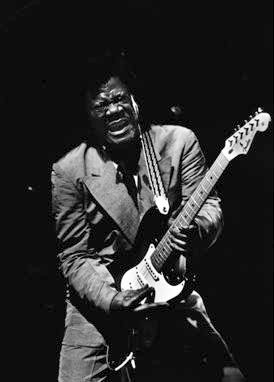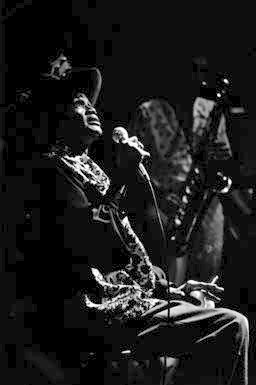

 |

|
Earl King, 1990 |

|
 |
Big Mama Thornton, 1983 |
Joseph A. Rosen is a working, exhibiting, professional photographer based in NYC. He regularly free-lances for major corporations as well as national and local publications. In addition, he has long standing relationships with many of the record labels producing Blues, Jazz and roots related music. His work has graced the CDs of artists such as Big Joe Turner, Eddie Vinson, Jimmy Witherspoon, Buckwheat Zydeco, Hubert Sumlin, J.B. Hutto, Mighty Joe Young, Solomon Burke, The Persuasions, Hank Crawford, Lou Donaldson, Roomful of Blues, Ronnie Earl, Sugar Ray Norcia, Bobby Radcliff, Kenny Neal, Michael Hill, Johnny Sansone, and many others.Like many of his generation, he became enamored of the Blues in the "Blues-boom" of the late 60's. "Friends who were slightly older than I gave me the first Paul Butterfield album, which I loved. I bought an Elmore James record because it had some tunes in common with the Butterfield album, and that was that. I was a stone Blues listener from that point on."
He first met up with BLUES ACCESS in New Orleans, where he was introduced by Bob Porter, host of NPR's PORTRAITS IN BLUE, to the Red Rooster. The friendship evolved through several JazzFests and some crazy nights at various New Orleans venues.
For last three years he has donated his photography to the Rhythm & Blues Foundation of Washington, DC for use in their PRESERVING AMERICA'S SOUL CALENDARS. The sale of these calendars benefited the Doc Pomus Fund for emergency relief of musicians in need.
"Doc Pomus, who wrote Save the Last Dance for Me, Lonely Avenue, This Magic Moment, Viva Las Vegas, among hundreds of others, was a friend and mentor, so when the R&B Foundation approached me about doing a calendar, I was more than glad to contribute. The Foundation is a great organization and deserves the support of your readers."
It was a combination of those nights in New Orleans and the viewing of the calendars that led to this spread in BLUES ACCESS.
"Being a Blues fan, a Blues DJ (1975-81, Late Nite Blues, WYEP, Pittsburgh, PA) and a professional photographer naturally led me to start shooting the acts when they came to town. It was strictly a labor of love. I would give the guys prints the next time I saw them, get autographs, that sort of thing. Real fan stuff and real fun stuff."
"At the time the Blues was not enjoying the kind of mass exposure that they are now. Most of the acts, even big names like John Lee Hooker, Willie Dixon and Muddy Waters, could be seen in small rooms; joints (dumps, in many cases.) Festivals were rare. This was fine by me, because ultimately, I like the intimacy and intensity of clubs, particularly small ones. Don't get me wrong, I love festivals and I shoot festivals. I also shoot portraits in the studio. But, to me the blues is a night music and an emotional music and I find that most in the clubs and taverns. I like to reflect that in my photos. This lead to a certain 'look' in my photography; the lone figure emerging from the dark background. I like the drama of the spot lighting. When the photographs are successful, they are both portraits of the artist and of the blues."
"After 15 plus years of shooting like this, I, as well as some other people, realized I had an archive. Doc Pomus and I tried to get a book proposal together, but that never really got off the ground. We did have some great afternoons, watching baseball, listening to tunes and kicking it around. Then I met Bob Porter. Bob was interested in writing and had a friend who was a literary agent. One thing lead to another and suddenly we had a publishing deal with a major house. The only trouble was that the editor who signed us left the house and the book died a slow death. We had a similar, unpleasant experience with another publisher and we decided to shelve the project in that form. I've come to the conclusion that the publishing business is the music business in different clothing; very tough. I'm still looking for a book deal and do have a few nice possibilities cooking."
"Meanwhile, I just keep shooting. There is nothing better to me than to be up close to the stage with my Leica, quietly clicking away, while the artist is just pouring it out and the room is exploding with energy and dancers. That's my moment."
Joe will be having an exhibition of his music photography at WBGO Gallery, Newark, NJ from November 1996 through January 1997.
These and numerous other photographs of Blues, Rhythm & Blues, Soul, Jazz and other artists are for sale. Please direct inquires to:
Joseph A. Rosen
c/o Box One Photographic
200 W. Houston St. #1C
New York, NY 10014Tel # - 212-691-0607
Fax # - 212-255-2717E-Mail - RosJoBlu @AOL.Com.
 |
 |